Pattern formation in the exciton inner ring |
|
We report on the spatially separated pump-probe study of indirect excitons in the inner ring in the exciton emission pattern. A pump laser beam generates the inner ring and a weaker probe laser beam is positioned in the inner ring. The probe beam is found to suppress the exciton emission intensity in the ring. We also report on the inner ring fragmentation and formation of multiple rings in the inner ring region. These features are found to originate from a weak spatial modulation of the excitation beam intensity in the inner ring region. The modulation of exciton emission intensity anti-correlates with the modulation of the laser excitation intensity. The three phenomena - inner ring fragmentation, formation of multiple rings in the inner ring region, and emission suppression by a weak probe laser beam - have a common feature: a reduction of exciton emission intensity in the region of enhanced laser excitation. This effect is explained in terms of exciton transport and thermalization. M. Remeika, A.T. Hammack, S. Poltavtsev, L.V. Butov, J. Wilkes, A.L. Ivanov, K.L. Campman, M. Hanson, A.C. Gossard. Patterns formation in the exciton inner ring, arXiv:1304.5246 (2013), Phys. Rev. B 88, 125307 (2013). |
|
Inner ring due to exciton transport and energy relaxation
Excitation energy dependence of inner ring |
|
We report on the excitation energy dependence of the inner ring in the exciton emission pattern. The contrast of the inner ring is found to decrease with lowering excitation energy. Excitation by light tuned to the direct exciton resonance is found to effectively suppress excitation-induced heating of indirect excitons and facilitate the realization of a cold and dense exciton gas. The excitation energy dependence of the inner ring is explained in terms of exciton transport and cooling. Y. Y. Kuznetsova, J. R. Leonard, L. V. Butov, J. Wilkes, E. A. Muljarov, K. L. Campman, and A. C. Gossard, Excitation energy dependence of the exciton inner ring, arXiv:1202.3096 (2012), Phys. Rev. B 85, 165452 (2012). Y. Y. Kuznetsova, J. R. Leonard, L. V. Butov, J. Wilkes, A. Ivanov, A. C. Gossard, Excitation energy dependence of the exciton inner ring, APS March Meeting, March 21-25, 2011, Dallas, TX. |
|
Kinetics of inner ring |
|
The formation time of the inner ring following the onset of the laser excitation is found to be about 30 ns. The inner ring is also found to disappear within 4 ns after the laser termination. The latter process is accompanied by a jump in the photoluminescence (PL) intensity. The spatial dependence of the PL-jump indicates that the excitons outside of the region of laser excitation, including the inner ring region, are efficiently cooled to the lattice temperature even during the laser excitation. The ring formation and disappearance are explained in terms of exciton transport and cooling. A.T. Hammack, L.V. Butov, J. Wilkes, L. Mouchliadis, E.A. Muljarov, A.L. Ivanov, A.C. Gossard, Kinetics of the inner ring in the exciton emission pattern in GaAs coupled quantum wells, arXiv:0909.0790v1 (2009), Phys. Rev. B 80, 155331 (2009). |
|
Exciton inner ring: transport and energy relaxation |
|
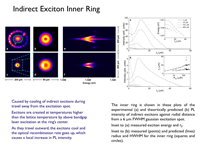
|
The inner ring in photoluminescence patterns of indirect excitons, with a radius up to tens of microns, is caused by exciton transport away from the excitation spot over macroscopic distances and cooling. L.V. Butov, A.C. Gossard, and D.S. Chemla, Macroscopically ordered state in an exciton system, cond-mat/0204482 April 22, 2002; Nature 418, 751 (2002) A.L. Ivanov, L.E. Smallwood, A.T. Hammack, Sen Yang, L.V. Butov, and A.C. Gossard, Origin of the inner ring in photoluminescence patterns of quantum well excitons, cond-mat/0509097 (2005); Europhys. Lett. 73, 920-926 (2006). |


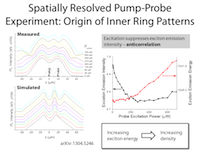
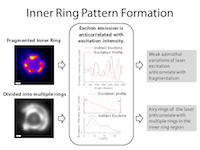
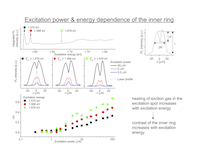
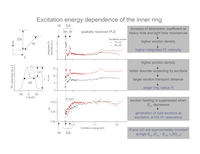
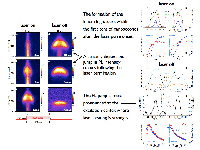
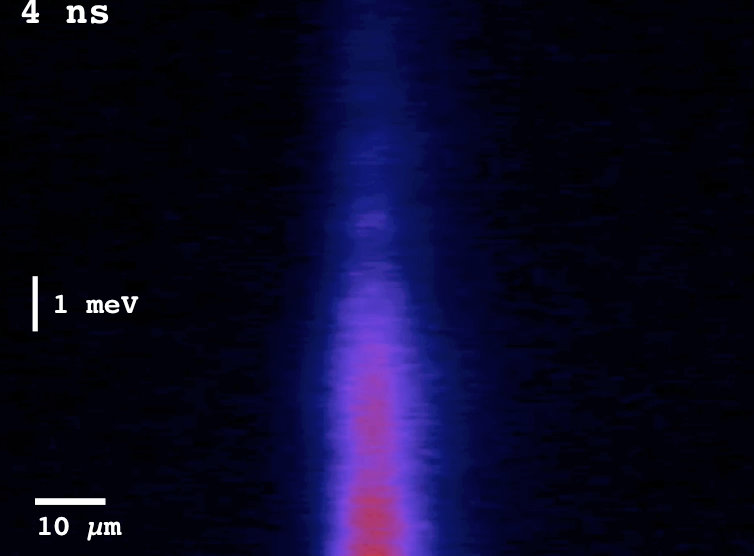
 (movie: laser off)
(movie: laser off)
